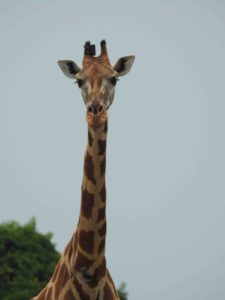USING MODERN TECHNOLOGY TO SAVE GIRAFFE AND THEIR HABITAT
In April 2018, the Giraffe Conservation Foundation (GCF) in partnership with the Uganda Wildlife Authority (UWA) undertook the largest ever GPS satellite tagging of giraffe in order tobetter understand their spatial movements and habitat use in the wild. Twenty-five (25) newly designed and tested solar powered GPS satellite units were fitted to giraffe in Kidepo Valley and Murchison Falls National Parks in northern Uganda.
Uganda is at the forefront of giraffe conservation with these trails of new technology. In recent years, the UWA conducted three successful giraffe translocations and recently the country finalised its first-ever National Giraffe Conservation Strategy and Action Plan – all with the support of GCF.
finalised its first-ever National Giraffe Conservation Strategy and Action Plan – all with the support of GCF.
While fitting 25 tracking units sounds like an easy task, this is not such a simple exercise with giraffe. Each giraffe was carefully tackled by the skilled UWA veterinary team and fitted with a unit. Important biodata was collected simultaneously including measurements, genetic and blood samples, skin disease assessment, while the giraffe was also treated with medication to help with potential current and future health problems. While in the park, the veterinary team also removed snares from a giraffe and a young elephant that were observed with snares during the tagging exercise – making this an all-round conservation success.
Since their first use, giraffe satellite units have gone through quite a design evolution. These new units are small (the size of 3 matchboxes), less obtrusive and have increased technology and battery capacity compared to giraffe collars and head harnesses that were used in the past. Interestingly, the first-ever giraffe GPS satellite units were trialled by the GCF Directors Dr Julian & Steph Fennessy in Namibia in 2001, and several design iterations have evolved since.
Developed in partnership with Savannah Tracking, Kenya, GCF has continued to adapt and fit these new light-weight solar powered units on giraffe in three African countries already. This is part of a new and exciting Africa-wide initiative named Twiga Tracker (‘twiga’ is Swahili for giraffe). Twiga Tracker is a collaboration between GCF, Smithsonian Conservation Biology Institute, San Diego Zoo Global and Wildlife Conservation Alliance that aims to better understand spatial movements of all four giraffe species and their use of habitat. Using science as a base to support long-term giraffe conservation, Twiga Tracker plans to study >250 giraffe across their range. Contact us for more information and get in touch if you would like to become part of this exciting initiative by providing funding support.
 Giraffe face many threats in the wild, such as loss of large scale habitat, fragmentation and degradation of their preferred habitat, disease and illegal hunting (poaching). These threats were also highlighted by the IUCN SSC Giraffe & Okapi Specialist Group when giraffe were uplisted to ‘Vulnerable to extinction’ on the IUCN Red List in December 2016.
Giraffe face many threats in the wild, such as loss of large scale habitat, fragmentation and degradation of their preferred habitat, disease and illegal hunting (poaching). These threats were also highlighted by the IUCN SSC Giraffe & Okapi Specialist Group when giraffe were uplisted to ‘Vulnerable to extinction’ on the IUCN Red List in December 2016.
As part of the continent-wide Twiga Tracker initiative, the recent GPS satellite tagging of giraffe in Uganda will allow our team to monitor the movements and habitat use of the tagged giraffe in these critical refuges over the next few years. Nubian giraffe numbers have dropped by >95% in the past 30 years alone, and it is critical to better understand their needs now to help protect these threatened giraffe. While technology can help conservation, is important to compliment these technological advances with on-ground field-based monitoring to understand the full picture. GCF in collaboration with UWA and other partners such as Dartmouth College, USA, have done just that for the past four years and the results are helping us to make informed management decisions.
World Giraffe Day (WGD) – 21 June is an annual celebration of our tall friends on the longest day (or night – depending on your hemisphere!). WGD is an initiative of GCF and WGD 2018 is dedicated to support conservation management of giraffe in Uganda, including Operation Twiga III, a conservation translocation of Nubian giraffe from Murchison Falls NP to Kidepo Valley NP to further bolster the small resident population. Giraffe conservation translocations in Uganda have proven very successful with two new populations (now only four in total) established in the last three years. Both new populations recently reported the birth of new giraffe calves, making these great conservation successes. With GCF’s technical and financial support UWA has created an exciting and successful giraffe conservation programme in the country which can be considered one of the best in the world.
GCF appreciates the valuable financial support for its Uganda project from Adventure Consults Uganda, Blair Drummond Safari and Adventure Park, Boissiere-Mervent Conservation, Chester Zoo, Cheyenne Mountain Zoo, Cleveland Metroparks Zoo, Columbus Zoo, Dallas Zoo, Fort Wayne Children Zoo, Maltz Family Foundation, NABU, Riverbanks Zoo and Garden, Total Uganda E&P, Utah’s Hogle Zoo, Wildlife Conservation Alliance, Wild Places, World Giraffe Day and WoodTiger Fund. Together we can make a difference and increase Nubian giraffe numbers and their distribution in Uganda long-term.

